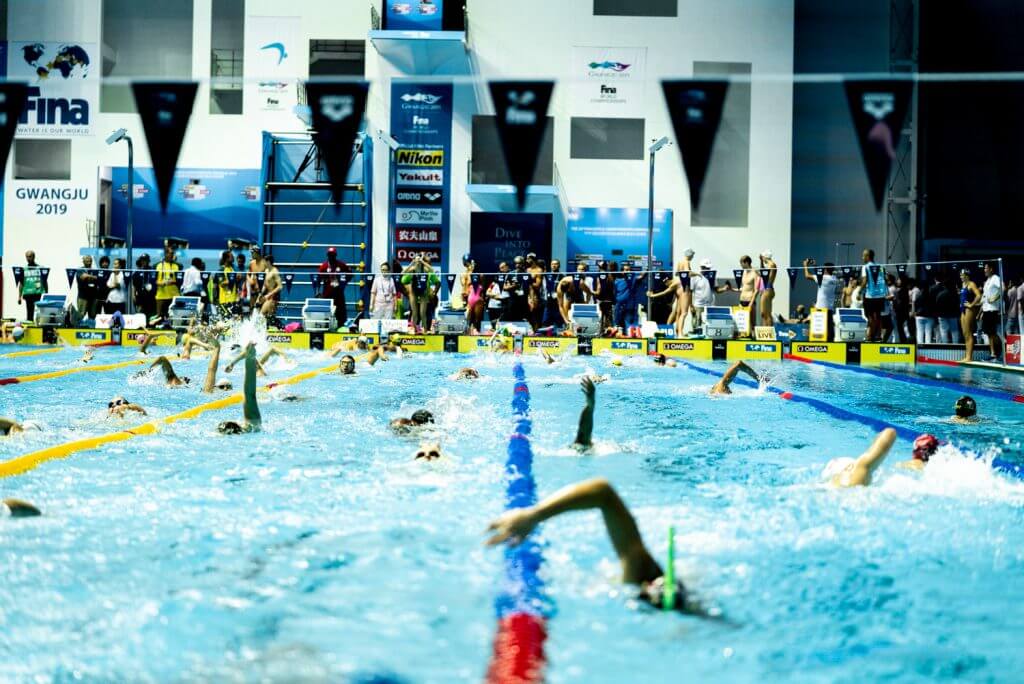7 Unspoken Rules of Lane Etiquette

Do The Right Thing: The Unspoken Rules of Lane Etiquette
Any swimmer knows the unspoken rules of sharing a lane with other swimmers, whether it is at a meet or at practice with the familiarity of your own team. It is crucial to have lane etiquette. The lanes are small and swimmers need to be able to practice without annoying or getting in each other’s way. This is especially important when the swimmer is unfamiliar with the people they are swimming with. This happens most commonly at larger championships. It can be a general warmup lane where it is every athlete for themselves. Or, it can be the warmdown lane where everyone is expected to share the space so they can get a proper warmdown after their events.
Here are some rules to follow:
1. Five Seconds Apart
The first rule every swimmer learns is to wait five seconds before leaving after another swimmer. This guideline is to ensure that the swimmer that leaves first has enough space to swim comfortably. This also benefits the swimmer leaving because they will not have to cram their stroke. Nobody wants someone to be on their feet the whole time, so it is so important to respect others when leaving the wall. Nothing is worse than the feeling of someone dragging you down because they did not leave the wall at the correct time.
2. Let the Faster Person Go
Whether the fastest person in the lane caught up to you or you both just started off, it is important to let the faster person lead. Every swimmer wants to get the most out of practice so if people are getting held up by someone, it is very frustrating. The general rule is to let someone go if they touch your feet. When people do not move, it can be dangerous as well. An athlete can get kicked or scratched and nobody wants to hurt their friends or teammates.
Try to find lanes with people of similar speeds. If you know that you cannot keep up with the fast interval, find one that works so you do not have someone on your feet or so you do not catch up to others.
3. Follow the Leader
If there is a large group of people doing one specific warmup, do not go into the lane and do your own thing. You should respect the larger group. If you know you need to do something specific, find a way to either be respectful or find a separate lane where there is more of a generalized warmup.
4. Don’t Swim in the Middle of the Lane
Lanes are small but they are big enough so people can stay on one side. If someone is swimming in the middle of the lane, it makes it difficult and dangerous for the others to swim. Collisions can happen or practices can be disrupted. The only time swimming in the middle of the lane is okay is on three occasions: If you have the lane completely to yourself; When you are working on sprints or starts; While competing.
5. Taking a Break
It happens to everyone, the inevitable need for a break. It is important when sharing a lane to make sure that if you need a break that you move out of the way of other swimmers. Do not stop in the middle of the lane. This can be dangerous for you and unfair to other swimmers. If the situation comes up where you need to rest, it is best to either step out of the pool or move to the corner of the lane. This ensures that you do not get in the way of other swimmers.
That being said, if someone is in the middle of the lane, do not flip turn on them. A swimmer should try to make an active effort to ensure the safety of others.
6. Yield to Oncoming Traffic
If a swimmer is doing their laps, do not push off at the same time as them. If you find yourself resting, make sure that you let the person already moving go. When a swimmer pushes off at the same time, it can be very dangerous for both people. The person already swimming has a lot of momentum. All swimmers know the struggle of gaining momentum after being interrupted. It is only fair that we do not disrupt others.
7. Pick the Empty Lane
If there are lanes open, do not go into the lane that already has someone in it. That being said, if all the lanes are full, a swimmer should find the lane with the least amount of people. It can be unfair to other swimmers if four of your teammates are in one lane and two in the other. We are all here to train and practice so it is polite to equal out the lanes.
These lessons are learned very early in swimmers’ careers. Swimmers are taught to do everything we can to be courteous to others when sharing a lane.
All commentaries are the opinion of the author and do not necessarily reflect the views of Swimming World Magazine nor its staff.




I agree with all of these. Butterfly swimmers have a hard time and need to time their stroke. Backstroke swimmers good luck
There is one wrong thing on this list. Always do your flip turn as though it’s an empty wall. It is 100% on the person blocking the wall if they get kicked.
I don’t agree. Someone may be new to competition and courtesy is always a priority. Education is best.
Great points to remind everyone.
If swimmer taps your foot then let them pass.